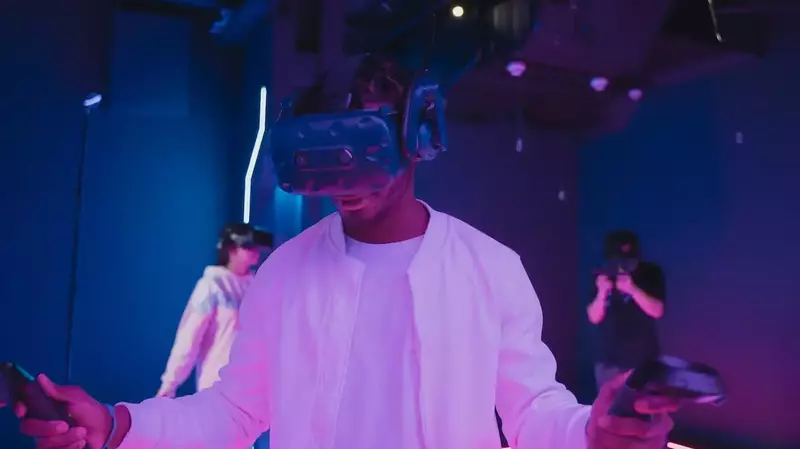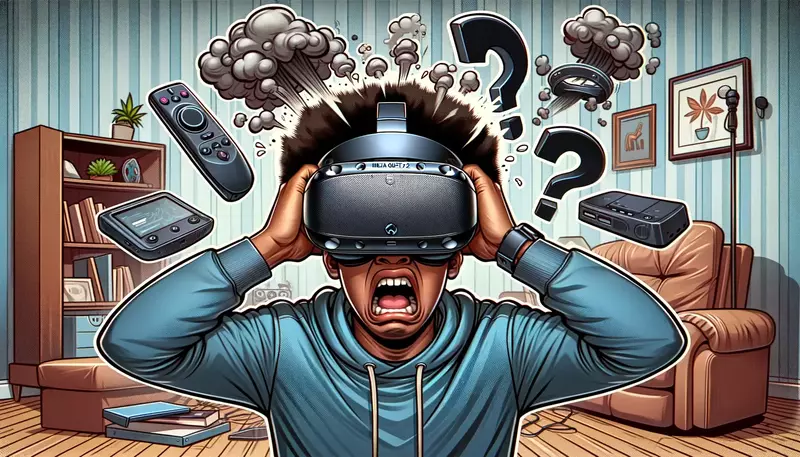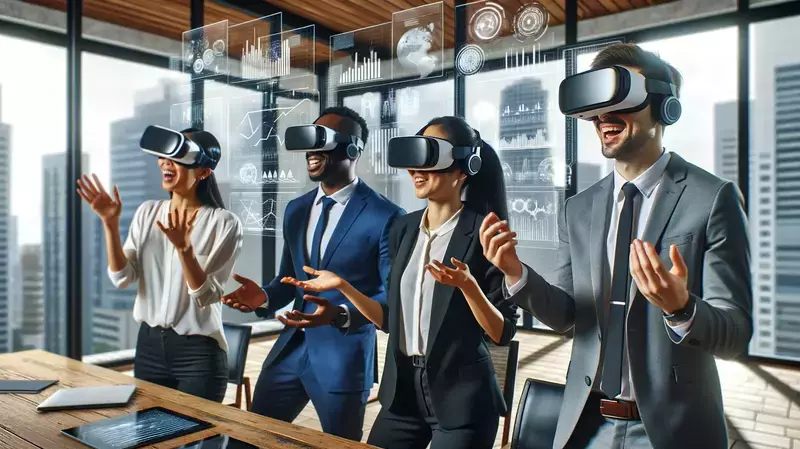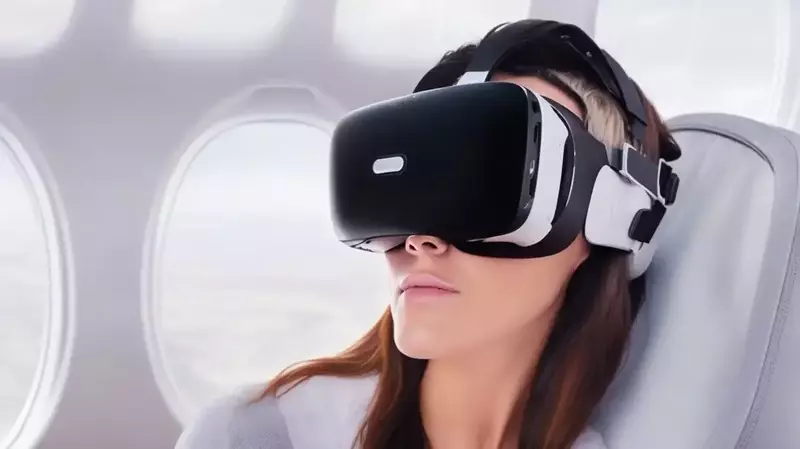This site contains affiliate links to products, and we may receive a commission for purchases made through these links.
Does the HTC Vive Pro 2 have finger tracking? This is a question many gamers and virtual reality enthusiasts are asking as they consider investing in this cutting-edge VR headset.
In this post, we’ll look into the concept of hand gestures and gesture recognition technology to answer whether the HTC Vive Pro 2 supports finger tracking.
We’ll begin by exploring what exactly the HTC Vive Pro 2 is, before diving into its capabilities for finger tracking. Next, we will discuss the specific tracking method used by this VR headset and how it compares to other PC VR headsets on the market.
Finally, we’ll examine both advantages and disadvantages of having finger tracking on HTC Vive Pro 2, helping you make an informed decision about whether or not this feature-rich device is right for your virtual world explorations. Stay tuned as we unravel everything there is to know about finger tracking with the HTC Vive Pro 2.

What is HTC Vive Pro 2?
The HTC Vive Pro 2 is a state-of-the-art virtual reality headset designed to provide gamers, explorers and those interested in exploring the world of VR with an immersive experience featuring high resolution visuals, precise tracking and ergonomic design.
The HTC Vive Pro 2 offers an engaging experience with incredibly detailed visuals, exact tracking, and a comfortable design.
This VR headset boasts several features that set it apart from its competitors:
- 5K resolution: The HTC Vive Pro 2 has a combined resolution of 4896 x 2448 pixels across both eyes, providing crisp images and reducing the screen-door effect often seen in other VR headsets.
- 120Hz refresh rate: A higher refresh rate ensures smoother motion and reduces motion sickness while using the device.
- Foveated rendering technology: This feature optimizes GPU usage by only fully rendering areas where the user’s gaze is focused while lowering the quality of peripheral vision areas.
- Ergonomic design: The adjustable strap system allows users to find their perfect fit for comfortable extended use sessions.
In addition to these standout features, the HTC Vive Pro 2 also supports a wide range of accessories such as wireless adapters and various controllers compatible with different applications or games.
With all these attributes combined, this VR headset aims to provide users with an unparalleled immersive experience in gaming or exploring new worlds through virtual reality simulations.
Does HTC Vive Pro 2 Have Finger Tracking?
When it comes to finger-tracking capabilities, the HTC Vive Pro 2 does not have native support for this feature.
Although the HTC Vive Pro 2 does not come with built-in finger tracking functionality, there are third-party solutions available that can add this capability to your VR setup:
- Ultraleap’s Hand Tracking – By integrating Ultraleap’s hand tracking module, users can enjoy natural and intuitive interaction with virtual objects without the need for controllers.
- VIVE Tracker – The VIVE Tracker is a versatile accessory that can be attached to various peripherals or even your fingers, allowing you to bring real-world objects into VR experiences. When combined with compatible gloves like the Manus VR Gloves, it enables precise finger tracking in supported applications.
In summary, although native finger tracking isn’t present on the HTC Vive Pro 2 out-of-the-box, it’s possible to achieve similar results by incorporating additional hardware and software into your VR setup.
What Tracking Method Does Vive Pro 2 Use?
The HTC Vive Pro 2 uses a tracking method known as SteamVR Tracking, which is based on the Lighthouse technology developed by Valve Corporation.
This system provides highly accurate and low-latency positional tracking for both the headset and controllers.
How SteamVR Tracking Works
SteamVR Tracking relies on two or more base stations placed in opposite corners of your play area.
These base stations emit infrared light that sweeps across the room at regular intervals, allowing sensors on the HTC Vive Pro 2 headset and controllers to detect their position relative to each other.
- Precision: The Lighthouse technology offers sub-millimeter precision when it comes to positioning data, ensuring smooth movement within virtual environments.
- Larger Play Area: With this system, users can enjoy a larger play area (up to 10m x 10m) compared to other VR systems like Oculus Rift S or PlayStation VR.
- No Camera Required: Unlike some other VR headsets that require external cameras for tracking purposes, SteamVR’s lighthouse-based approach eliminates any need for additional hardware beyond the base stations themselves.
The HTC Vive Pro 2 employs a laser-guided tracking system to precisely monitor the user’s movements. This technology offers many advantages, which will be discussed in more detail in the next heading.
The HTC Vive Pro 2 does not have built-in finger tracking, but it uses SteamVR Tracking for highly accurate positional data. Third-party solutions like Ultraleap’s Hand Tracking and VIVE Tracker with compatible gloves can add finger and hand tracking capabilities to enhance the VR experience.
Advantages of Finger Tracking on HTC Vive Pro 2
The introduction of finger-tracking technology in virtual reality headsets has opened up a world of possibilities for gamers, explorers, and those looking to learn about virtual reality.
While the HTC Vive Pro 2 does not come with native finger tracking capabilities, it can still benefit from this advanced feature through compatible accessories like the Valve Index Controllers.
In this section, we will discuss some advantages that finger tracking can bring to your VR experience when using the HTC Vive Pro 2.
A. Enhanced Immersion and Realism
Finger tracking allows users to interact with their virtual environment more naturally by accurately replicating hand movements within the game or application. This level of immersion is unmatched by traditional controllers and helps create a more realistic experience for users as they navigate through various VR worlds.
B. Improved Interaction and Control
With precise finger movement detection, users gain better control over their actions in-game or during simulations.
This means you can perform complex tasks such as picking up small objects or manipulating tools with ease – something that may be challenging using standard motion controllers alone.
C. Accessibility for Users With Disabilities
Finger tracking technology provides an opportunity for individuals who have limited mobility or dexterity issues to participate fully in VR experiences without being hindered by physical limitations associated with traditional controller use.
D. Greater Range of Applications Beyond Gaming
Finger-tracking technology can be utilized in a wide variety of industries, including education, healthcare and design, to enable more accurate manipulation of 3D models or virtual surgical simulations.
For example, architects can use finger tracking to manipulate 3D models of buildings with greater precision or medical professionals can practice complex surgical procedures in a virtual environment.
E. Future-Proofing Your VR Experience
As more developers continue to create content that takes advantage of finger-tracking technology, investing in compatible accessories for your HTC Vive Pro 2 ensures you’ll be able to enjoy the latest innovations in virtual reality without needing to upgrade your entire headset setup.
In summary, while the HTC Vive Pro 2 does not have built-in finger tracking capabilities, users can still benefit from this advanced feature by using compatible controllers like Valve Index Controllers.
The advantages of having finger tracking on your HTC Vive Pro 2 include enhanced immersion and realism, improved interaction and control within VR environments, increased accessibility for users with disabilities, expanded applications beyond gaming experiences into other industries such as education and healthcare settings, as well as future-proofing your VR experience against upcoming advancements in technology.
The advantages of finger tracking on HTC Vive Pro 2 provide a more immersive experience, allowing for greater control and precision in virtual reality. However, there are also some drawbacks to consider when using this feature; the next heading will discuss these disadvantages in detail.
The HTC Vive Pro 2 does not have native finger tracking capabilities, but users can still benefit from this feature by using compatible accessories like the Valve Index Controllers. Finger tracking provides enhanced immersion and realism, improved interaction and control within VR environments, increased accessibility for users with disabilities, expanded applications beyond gaming experiences into other industries such as education and healthcare settings, as well as future-proofing your VR experience against upcoming advancements in technology.
Disadvantages of Finger Tracking on HTC Vive Pro 2
Despite its potential to increase immersion and interaction in virtual reality, there are some drawbacks associated with finger tracking on the HTC Vive Pro 2 that should be taken into consideration.
In this section, we will explore a few disadvantages that users may experience when utilizing finger tracking capabilities.
A. Limited Compatibility with Games and Applications
The first disadvantage worth mentioning is limited compatibility with games and applications. Since not all VR titles are designed to support finger tracking, users might find themselves unable to fully take advantage of this feature in many popular games or experiences.
This can lead to frustration for those who invested in a high-end headset like the HTC Vive Pro 2 expecting more widespread adoption of advanced input methods such as finger tracking.
B. Additional Hardware Requirements
Finger tracking often requires additional hardware components beyond what comes standard with the HTC Vive Pro 2 package.
For example, Valve’s Index Controllers – also known as “Knuckles” controllers – offer individual finger sensing but need to be purchased separately from your headset bundle (source).
These extra costs can add up quickly for consumers who want access to cutting-edge features without breaking their budget.
C. Learning Curve and Adaptation Period
- New Interaction Paradigm: Users accustomed to traditional controller-based inputs may require time and practice before they become proficient at using natural hand gestures for navigation or object manipulation within virtual environments.
- Gesture Recognition: Some users might experience difficulties with gesture recognition, as certain hand movements or poses may not be accurately detected by the tracking system. This can lead to frustration and a less immersive VR experience.
D. Ergonomics and Fatigue
Finger-tracking technology often encourages users to engage in more natural, free-form interactions within virtual environments. Still, this type of control could lead to higher levels of fatigue and muscular stress when used for longer periods.
Users should be mindful of their comfort levels when using finger tracking for long sessions, taking breaks as needed to prevent discomfort or injury.
Potential HTC Vive Pro 2 buyers should contemplate the advantages and disadvantages before settling on whether finger tracking is a must-have for their virtual reality experience.
While there are undoubtedly benefits associated with advanced input methods like finger sensing, some drawbacks must be considered when evaluating its overall impact on user satisfaction and immersion.
The HTC Vive Pro 2 has finger tracking capabilities, but there are some disadvantages to consider. These include limited compatibility with games and applications, additional hardware requirements, a learning curve and adaptation period for users accustomed to traditional controller-based inputs, and potential ergonomics and fatigue issues. Potential owners should weigh the pros and cons before deciding if finger tracking is an essential feature for their VR experiences.
Finger Tracking vs. Hand Tracking: What’s the Difference?
While finger tracking and hand tracking might seem similar, they have distinct differences in terms of functionality. Finger tracking focuses on detecting individual finger movements and gestures, whereas hand tracking detects the position and orientation of your entire hand.
The HTC Vive Pro 2 does support hand tracking, thanks to its advanced SteamVR Tracking technology. This system uses external base stations that emit infrared light to track the movement of your headset and controllers with high precision (source).
However, it is important to note that this method primarily tracks controller-based interactions rather than direct hand or finger input.
The Vive Pro 2 utilizes a mixture of cameras and sensors to monitor the user’s actions, though it does not have finger tracking. Here is an overview of the biggest differences between finger tracking and hand tracking:
| Aspect | Finger Tracking | Hand Tracking |
|---|---|---|
| Definition | The ability to track the movements of individual fingers in virtual reality. | The ability to track the position and movement of the entire hand in virtual reality. |
| Sensors | Usually uses a combination of sensors such as capacitive sensors, optical sensors, and IMU sensors to detect finger movements. | Usually uses camera-based sensors or depth sensors to detect the position and movement of the entire hand. |
| Accuracy | Finger tracking is generally more accurate than hand tracking, as it can track the movement of individual fingers. | Hand tracking can be less accurate than finger tracking, as it may not be able to detect small finger movements or movements that are partially obscured from the sensors. |
| Immersion | Finger tracking can greatly enhance the sense of immersion in virtual reality by allowing users to interact with objects in more natural ways. | Hand tracking can also enhance immersion, but to a lesser extent than finger tracking, as it does not allow for as much fine-grained control over virtual objects. |
| Ease of use | Finger tracking can be more challenging to set up and calibrate than hand tracking, as it requires more sensors and more precise calibration. | Hand tracking can be easier to set up and use than finger tracking, as it requires fewer sensors and less precise calibration. |
| Applications | Finger tracking is particularly useful for applications that require fine-grained manipulation of virtual objects, such as surgery simulations or virtual musical instruments. | Hand tracking can be useful for a wide range of virtual reality applications, such as gaming, training simulations, and social interactions. |
FAQ
Does HTC Vive Pro 2 have finger tracking?
No, the HTC Vive Pro 2 does not have native finger tracking. It uses the SteamVR Tracking system with external base stations and controllers for hand and body movement tracking.
Does HTC Vive Pro have finger tracking?
The original HTC Vive Pro also lacks native finger tracking capabilities. Like its successor, it relies on the SteamVR Tracking system using external base stations and controllers.
What VR has finger tracking?
The Oculus Quest 2 is a popular VR headset that offers built-in hand and finger tracking, allowing users to interact with virtual environments without needing physical controllers.
Which tracking method does Vive Pro 2 use?
Vive Pro 2 utilizes SteamVR Tracking, which employs external base stations (Lighthouse) to track user movements accurately through infrared lasers. This technology provides precise positioning data for both headsets and controllers in virtual reality experiences.
!! For more information about the different VR headsets on the market, check out this product specification list.
Final Thoughts
HTC Vive Pro 2 is a cutting-edge virtual reality headset, delivering immersive visuals and experiences. Gamers often seek VR headsets with finger tracking, a technology that allows for more natural interaction within the virtual environment.
Unfortunately, HTC Vive Pro 2 does not have built-in finger tracking. However, it uses external controllers that offer precise movement tracking and an excellent gaming experience. If you’re looking for a VR headset with finger tracking capabilities, you might want to consider other options like Valve Index or Oculus Quest 2.
If you’re interested in exploring different VR headsets’ features and finding one that suits your needs best, check out Project Meta’s website. They provide comprehensive reviews and comparisons of various VR devices to help you make an informed decision.

Espen
Espen is the Director of PursuitMeta and has written extensively about Virtual Reality and VR Headsets for years. He is a consumer product expert and has personally tested VR Headsets for the last decade.




Leave a Reply